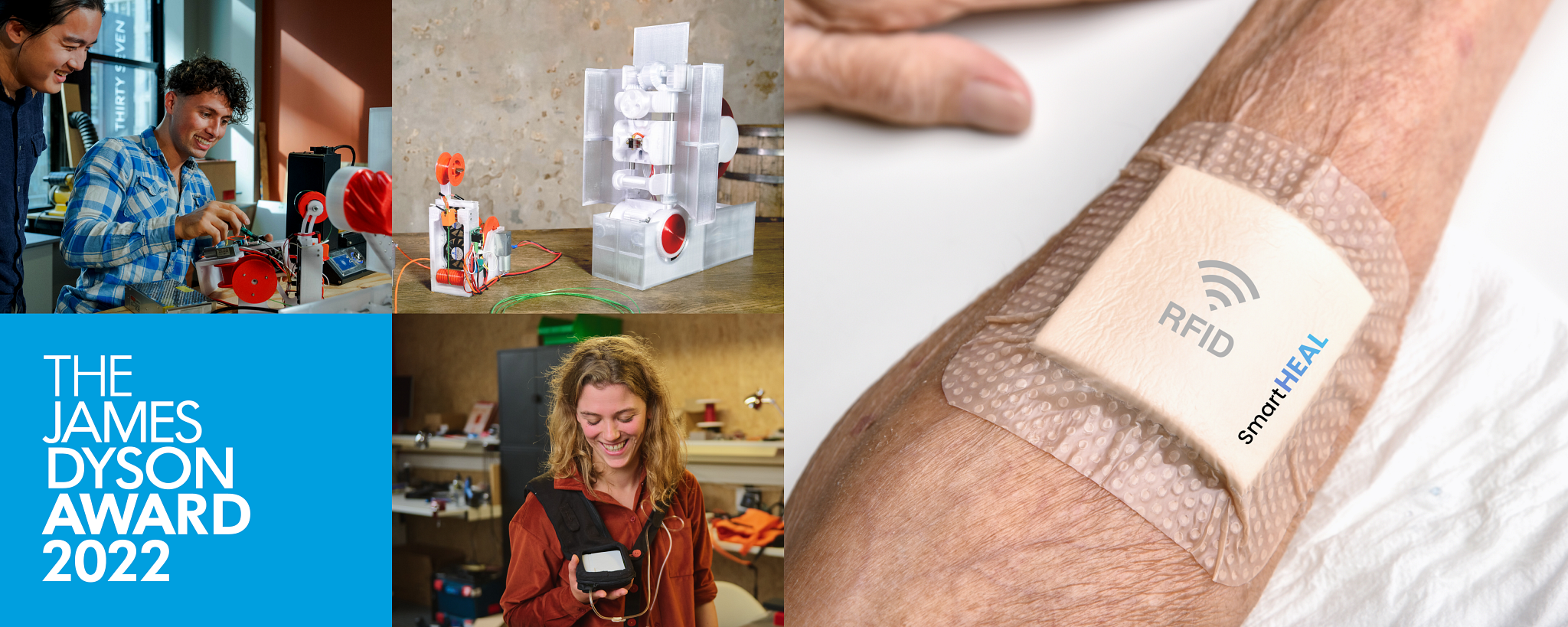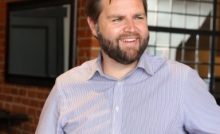2022 James Dyson Award Global Winners announced


- SmartHEAL, A smart sensor for dressings which indicates how well a wound is healing by measuring its pH level, invented by students from Warsaw University of Technology, Poland
- Polyformer, A machine that recycles plastic bottles into affordable 3D printer filament for developing nations, invented by students from McMaster University, Canada
- Ivvy, A wearable replacement for the existing intravenous drip pole apparatus, improving comfort and mobility for patients, invented by Charlotte Blancke from the University of Antwerp, Belgium


HONG KONG SAR – Media OutReach – 16 November 2022 – The James Dyson Award has given more than �1m in prize money to over 300 promising inventions from young engineers and scientists around the world. This year, Sir James Dyson has selected two global winners, each receiving £30,000, and one runner-up, receiving £5,000 in prize money, to support the next stages of their inventions.
Commenting on this year’s competition, Sir James Dyson said:
“Every year, the James Dyson Award offers proof that young people are passionate about improving the planet and solving environmental and medical problems. There are people who grandstand over the issues they care about, but these young inventors are doing something more productive. They are diligently applying themselves to problem-solving using engineering, science and ingenious design.”
The winning inventions
International winner SmartHEAL, invented by Tomasz Raczy?ski, Dominik Baraniecki and Piotr Walter
The problem
When covered by a dressing, it is very hard to know how well a wound is healing. The most common mistake in wound healing is changing the dressing too often, which can lead to infections and tissue disruption.[1]
Current methods of assessing a wound rely on subjective scoring of colour, smell, temperature or expensive laboratory biochemical tests.[2] Poor wound healing not only leads to tissue inflammation, but also necrosis (death of body tissue that is irreversible), and can lead to severe illness or death.
The Diabetes Hong Kong reported that there are currently more than 700,000 diabetes patients in the city, accounting for 10% of the overall population with the trajectory to surge to 920,000 by 2030.[3] Therefore, diabetes-triggered foot ulcers will potentially become the major chronic wounds that Hong Kong public ought to face in the long term.[4]
The solution
SmartHEAL is a precise, affordable and scalable smart pH sensor for dressings. By using Radio-Frequency Identification (RFID) communication systems and monitoring the pH of a wound, SmartHEAL can assess the wound’s condition and detect infection without removing the dressing, and therefore without disrupting the tissue.[5] Medical professionals can subsequently analyse the data and prescribe the appropriate treatment for the wound. Smart bandages create and preserve a balanced wound environment.[6]
“We’ve all nervously peeled back a dressing or plaster to see what is happening underneath. SmartHEAL, a smart dressing, has won the International James Dyson Award because it provides doctors and patients with a key piece of data the pH level that can tell them how a wound is healing. This can improve treatment and prevent infection, saving lives. I hope the Award will give the team impetus to proceed down the tricky path towards commercialisation.” Sir James Dyson, Founder and Chief Engineer at Dyson.
Next steps
The team will finish testing and then start clinical trials. Their aim is to then finish the certification process in three years’ time so they can start to distribute and sell SmartHEAL dressings in 2025.
On winning the James Dyson Award International prize, the SmartHEAL team said: “We are super excited to be the International Winners of the James Dyson Award this year! This is and will be a great opportunity for us to become a part of something bigger, something that hopefully can change the world. We strive to refine our prototype, obtain a patent and pass the necessary clinical trials to commercialise SmartHEAL. We were honoured to be greeted by Sir James Dyson himself. His words: “Congratulations! You are the International winners of the James Dyson Award “still ring in our ears we’re still in disbelief, joy and happiness!”
Facts and stats
- It is estimated that 1 to 2 % of the population will experience a chronic wound during their lifetime in developed countries. [7]
- The dramatic increase in the ageing population will increase these numbers as wound closure is negatively associated with age.
- According to the service data from the Wound Care Unit across Hong Kong West Cluster, 3200 patients were served in 2015 and the number continues to grow.[8]
Sustainability winner Polyformer, invented by Swaleh Owais and Reiten Cheng
The problem
While working at a makerspace in Rwanda, Swaleh and Reiten learned that many locals could not use the makerspace’s 3D printers, due to the high price of importing filament to the country.[9] They also observed the lack of infrastructure to recycle plastic bottles in Rwanda.
The solution
Polyformer is a low-cost machine that turns plastic bottles into 3D printer filament. Polyformer cuts plastic bottles into long strips that are fed into an extruder. The strip is then thermoformed into 1.75mm filament, as it goes through a nozzle. The filament is passed through vents to cool the plastic before it is wrapped around a spool, ready to be inserted into a 3D printer.
The invention is targeted at developing nations due to the high price of importing 3D printer filament. With Polyformer, makers have easier access to cheap, high-quality 3D printer filament. This encourages usage of design infrastructure and career consideration in developing nations, while empowering makers to recycle their own waste and use the output productively. [10]
“By turning used plastic bottles into 3D printer filament, Polyformer helps reduce the amount of waste going to landfill and provides a cheap and plentiful material for engineers and designers, especially in developing countries. Their idea will provide new opportunities for other inventors to prototype their ideas using 3D printing.” Sir James Dyson, Founder and Chief Engineer at Dyson.
Next steps
Currently, Swaleh and Reiten are building new Polyformers to deploy at their partner makerspaces in Rwanda and they are designing new inventions within the Polyformer project, such as the Polyjoiner, Polydryer, Polyspooler, and many more.
Polyjoiner
A standard 500ml plastic bottle can only produce 3m of filament, which is not long enough for most print jobs. Therefore, Swaleh and Reiten have developed Polyjoiner, a mechanism that can automatically join multiple strands of printer filament together into a long singular piece. Here is a brief demo: https://youtu.be/JGTlgK1d208.
Polydryer
PET is hygroscopic, which means a plastic water bottle is likely to absorb some of the water it’s filled with. The presence of water in filament negatively impacts print quality. Therefore, Swaleh and Reiten are developing Polydryer, a low-cost machine that evaporates moisture from 3D printer filament.
Polyspooler
Long strands of 3D printer filament must be wrapped around a spool. This ensures the filament does not get tangled while the printer is running. The Polyformer team are developing Polyspooler, a simple machine that automatically spools our recycled filament, thereby making the filament more practical to use.
The entire Polyformer project is 100% open-source with all CAD, code, and building instructions available on their discord: https://discord.gg/d6eYykSs. Open-source software can be beneficial for growth in developing countries due to a lower development cost, more security and better quality.[11] It supports collaboration, employment opportunities and skills development, encouraging community development and collective equity.[12]
After speaking to Sir James Dyson, Swaleh and Reiten said, “It is a great honor to be the James Dyson Award 2022 Sustainability winner. We are using the prize money to deploy several Polyformers and Polyformer-Lites at our partner makerspaces in Rwanda. With these machines, local students, designers, and makers in Rwanda will have access to low-cost 3D printer filament. This means they can use their community’s 3D printers more frequently! If you would like to build your own Polyformer, please check out our Discord: https://discord.gg/77esvRwu.”
Facts and stats
- In 2019, over 100 tonnes of plastic containers disposed at landfills daily in Hong Kong were plastic beverage containers, with over 90% of them made of polyethylene terephthalate (PET).[13]
- In 2019, landfills receive over 1.55 billion of plastic beverage containers which can fill up 2,690 double-decker buses. On average, each Hong Kong person disposes over 200 bottles per year. [14]
- The global 3D printing market size was valued at USD 13.84 billion in 2021 and is expected to expand at a compound annual growth rate (CAGR) of 20.8% from 2022 to 2030.
- Globally, 2.2 million units of 3D printers were shipped in 2021 and the shipments are expected to reach 21.5 million units by 2030.[15]
- A standard roll of 1kg of filament retails for around HK$366 in local markets. [16] The same roll of 3D printer filament can be purchased in Hong Kong for just HK$196. [17] This price difference is compounded by the lower purchasing parity in Rwanda. The exorbitant cost of filament creates a high barrier of entry for Rwandans to access 3D printing services.
- The first major factor that influences consumer recycling behaviour in developing countries is the accessibility of recycling services, often based on the convenience of recycling collection services. [18]
- Consumers who have easy access to recycling are 25% more likely to recycle.[19]
International runner up Ivvy, invented by Charlotte Blancke
The problem
Charlotte became aware that a colleague of her mother was unhappy about the uncomfortable apparatus her child was required to use for her medical treatment. The colleague mentioned that she in fact switched an intravenous pole for a coat hanger to improve her daughter’s comfort.
During Charlotte’s research, she found that at-home medical treatment is rising, but the equipment used for at-home intravenous therapies is the same as that in hospitals, despite the characteristics of a home setting being different. As more patients move to home healthcare services for recuperation or long-term care, complex medical devices are now used more frequently in the home, often under unsuitable conditions.[20]
The solution
Infusion therapy is when fluids or medication are administered through a cannula or needle at a controlled pace. [21] Ivvy replaces the current intravenous drip pole with a wearable device that provides patients with optimal mobility, an easy-to-use infusion pump, and on-board software so nurses can monitor their patients remotely.
Currently, there is a lack of feedback about intravenous treatments and existing infusion pumps have a complex interface. Charlotte has developed an infusion pump with a simplified interface and intuitive use. Nurses can easily set up the treatment at-home and patients can follow their therapy through a LED strip, display, and sound notifications.
“Being treated with an old-fashioned IV drip on a tall stand can make home seem like a hospital. Ivvy is a simple concept that could improve people’s treatment and enhance their quality of life. It shows the brilliance of simple design and I wish Charlotte every success in developing her idea towards commercialisation.” Sir James Dyson, Founder and Chief Engineer at Dyson.
Next steps
Charlotte is working with professionals in the industry to support her with further developing Ivvy.
Fact and stats
- The current IV pole is costly and has a complex design. There is no wireless communication between a nurse and the IV pole and the machines consume a large amount of power.[22]
- The most common type of IV stand is the free-standing mobile pole. The primary disadvantage of this design is that it is prone to falling over. The large height and relatively small base make it unstable. [23]
NOTES TO EDITORS
The James Dyson Award forms part of a wider commitment by Sir James Dyson, to demonstrate the power of engineers to change the world. The competition has supported over 300 inventions with prize money, and is run by the James Dyson Foundation, an engineering-education charity funded by Dyson profits.
The Dyson Institute of Engineering and Technology and the Foundation’s work encourage aspiring engineers and problem solvers, to apply their knowledge and discover new ways to improve lives through technology. To date, James and the James Dyson Foundation have contributed over £140m to boundary-breaking concepts in education and other charitable causes.
This includes £12m to Imperial College London to create the Dyson School of Design Engineering, and £8m to Cambridge University to create the Dyson Centre for Engineering Design and the James Dyson Building.
At school level, the James Dyson Foundation offers robotics workshops, led by Dyson engineers, and provides free educational resources. These include its most recent launch, Engineering Solutions: Air Pollution: introducing young people to air pollution and engineering’s role in finding solutions.
The Foundation also supports medical research and the local community in Malmesbury where Dyson’s UK offices are based. Last summer, the Dyson Cancer Centre at Royal United Hospitals in Bath broke ground, and the Foundation continues to support the Race Against Dementia Dyson Fellow, Dr Claire Durrant, in accelerating finding better treatments for Alzheimer’s disease.
The Foundation has a website, Instagram, Twitter and YouTube.
Hashtag: #Dyson #JamesDysonAward
ABOUT THE INVENTORS OF SMARTHEAL
This year’s International winners are Tomasz Raczy?ski, Dominik Baraniecki and Piotr Walter, all current PhD students studying at Warsaw University of Technology, Poland. Tomasz is the team leader and technology expert, Piotr is the electrochemistry expert and Dominik is the electronics expert. The team came together five years ago over their shared interest in printed electronics. After multiple conversations with doctors and medics, they discovered the problem with the treatment of chronical wounds and decided to investigate this further; this is how SmartHEAL was created.
ABOUT THE INVENTORS OF POLYFORMER
This year’s Sustainability winners are Swaleh Owais (from Canada) and Reiten Cheng (from California). Swaleh is a recent engineering graduate studying in Canada at McMaster University, and Reiten is a recent industrial design graduate from ArtCenter College of Design in the USA, with a background in mechanical engineering. They met when Swaleh was waiting to board a flight and was scrolling through an online community of programmers (Discord), and he came across Reiten on the site. Swaleh worked at a 3D printing centre in Rwanda after graduating from university. He was inspired to invent Polyformer when he saw people were not able to 3D print due to the high price of importing filament into the country. Rwanda also lacks infrastructure to recycle plastic bottles, so Reiten and Swaleh had the perfect opportunity to design, program and build their invention.
ABOUT THE INVENTOR OF IVVY
Charlotte Blancke is a recent graduate of the University of Antwerp. Charlotte was searching for a thesis subject at university and heard her mother’s colleague complaining about the uncomfortable apparatus her child needed for medical treatment. She mentioned that she switched the intravenous pole for a coat hanger that she found in a store. With Ivvy, Charlotte tries to find a solution that tailors the equipment to the needs of patients and nurses in the home environment.
PREVIOUS GLOBAL WINNERS
-
Home Eye Pressure E-skin Sensor (HOPES) is a wearable biomedical device for pain-free, low cost, at-home intraocular pressure (IOP) testing. -
Plastic Scanner is a handheld device that when held against plastic will tell the user what materials it’s made from. It uses near-infrared spectroscopy, a technology that can categorise more than 75% of plastics. -
Invented by 23-year-old Judit Giró Benet, The Blue Box is a new way to detect breast cancer, at-home, using a urine sample. -
Invented by 27-year-old Carvey Ehren Maigue, AuREUS is a new material, made from waste crop, which converts UV light into renewable energy. The Sustainability prize was newly created in 2020. -
MarinaTex is a home compostable material designed as an alternative to single-use plastic films. The material is comprised of waste material from the fishing industry and sustainable algae. -
O-Wind Turbine is an omnidirectional wind turbine that can capture wind travelling in any direction, unlike conventional turbines. This allows it to be used in urban environments where wind flow is multi-directional. -
The sKan is a low cost and non-invasive melanoma detection device invented by a team of medical and bioengineering undergraduates from McMaster University, Canada. The team are currently using the prize money to refine their design to ensure it passes the US Food and Drug Administration standards.
ABOUT THE COMPETITION
The brief. Design something that solves a problem. This problem may be a frustration that we all face in daily life, or a global issue. The important thing is that the solution is effective and demonstrates considered design thinking.
The process. Entries are judged first at the national level by a panel of external judges and a Dyson engineer. Each operating market awards a National winner and two National runners-up. From these winners, a panel of Dyson engineers then select an international shortlist of 20 entries. The Top 20 Shortlist projects are then reviewed by Sir James Dyson who selects his international winners.
The prize
- The International winner receives a prize of £30,000
- Sustainability winner receives a prize of £30,000.
- International runners-up receive £5,000.
- Each National winner receives £5,000.
How to enter. Candidates enter through an online application form via the
Recent Posts
Daphne Announces 2024 Annual Results Revenue and Profit Attributable to Shareholders up 23% and 71% Respectively
Steady Final Dividend of HK$0.02 Per Share Dividend Payout Ratio was Approximately 35% (RMB' million)…
Last November was the time for EU beef in Manila, campaign led by Provacuno
MANILA, PHILIPPINES - Media OutReach Newswire - 26 March 2025 - Within the framework of…
Galaxy Macau™ and SCMP Learn Team Up to Inspire New Educational Pathways at Pioneering Parents’ Talk Held at GICC
Leading Education Experts Gather to Shape Conversations Around Global Education for the Next Generation MACAU…
Insulation Material Y-Warm: A New Era of Thin and Light Winter Apparels
BEIJING, CHINA - Media OutReach Newswire - 26 March 2025 - Even after over a…
Experience the Rich Fishing Heritage of Hong Kong with “Aberdeen 1773”
HONG KONG SAR - Media OutReach Newswire - 26 March 2025 - Hong Kong Fisherman's…
FBS Supports 250 Children in Indonesia During Ramadan
JAKARTA, INDONESIA - Media OutReach Neswire - 26 March 2025 - FBS, a leading global…


